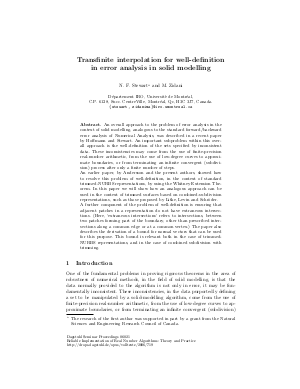Transfinite interpolation for well-definition in error analysis in solid modelling
Authors Neil Stewart, Malika Zidani
-
Part of:
Volume:
Dagstuhl Seminar Proceedings, Volume 6021
Part of: Series: Dagstuhl Seminar Proceedings (DagSemProc) - License:
 Creative Commons Attribution 4.0 International license
Creative Commons Attribution 4.0 International license
- Publication Date: 2006-09-13
File

PDF
DagSemProc.06021.9.pdf
- Filesize: 190 kB
- 12 pages
Document Identifiers
Subject Classification
Keywords
- Forward/backward error analysis
- robustness
- well-definition
- trimmed NURBS
- combined subdivision
- trimming
- bounds on normals
Metrics
- Access Statistics
-
Total Accesses (updated on a weekly basis)
0Document
0Metadata
Abstract
An overall approach to the problem of error analysis in the context of solid modelling, analogous to the standard forward/backward error analysis of Numerical Analysis, was described in a recent paper by Hoffmann and Stewart. An important subproblem within this overall approach is the well-definition of the sets specified by inconsistent data. These inconsistencies may come from the use of finite-precision real-number arithmetic, from the use of low-degree curves to approximate boundaries, or from terminating an infinite convergent (subdivision) process after only a finite number of steps. An earlier paper, by Andersson and the present authors, showed how to resolve this problem of well-definition, in the context of standard trimmed-NURBS representations, by using the Whitney Extension Theorem. In this paper we will show how an analogous approach can be used in the context of trimmed surfaces based on combined-subdivision representations, such as those proposed by Litke, Levin and Schröder. A further component of the problem of well-definition is ensuring that adjacent patches in a representation do not have extraneous intersections. (Here, "extraneous intersections" refers to intersections, between two patches forming part of the boundary, other than prescribed intersections along a common edge or at a common vertex.) The paper also describes the derivation of a bound for normal vectors that can be used for this purpose. This bound is relevant both in the case of trimmed-NURBS representations, and in the case of combined subdivision with trimming.
Cite As Get BibTex
Neil Stewart and Malika Zidani. Transfinite interpolation for well-definition in error analysis in solid modelling. In Reliable Implementation of Real Number Algorithms: Theory and Practice. Dagstuhl Seminar Proceedings, Volume 6021, pp. 1-12, Schloss Dagstuhl – Leibniz-Zentrum für Informatik (2006)
https://doi.org/10.4230/DagSemProc.06021.9
BibTex
@InProceedings{stewart_et_al:DagSemProc.06021.9,
author = {Stewart, Neil and Zidani, Malika},
title = {{Transfinite interpolation for well-definition in error analysis in solid modelling}},
booktitle = {Reliable Implementation of Real Number Algorithms: Theory and Practice},
pages = {1--12},
series = {Dagstuhl Seminar Proceedings (DagSemProc)},
ISSN = {1862-4405},
year = {2006},
volume = {6021},
editor = {Peter Hertling and Christoph M. Hoffmann and Wolfram Luther and Nathalie Revol},
publisher = {Schloss Dagstuhl -- Leibniz-Zentrum f{\"u}r Informatik},
address = {Dagstuhl, Germany},
URL = {https://drops.dagstuhl.de/entities/document/10.4230/DagSemProc.06021.9},
URN = {urn:nbn:de:0030-drops-7195},
doi = {10.4230/DagSemProc.06021.9},
annote = {Keywords: Forward/backward error analysis, robustness, well-definition, trimmed NURBS, combined subdivision, trimming, bounds on normals}
}
